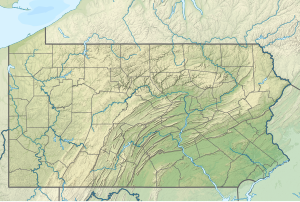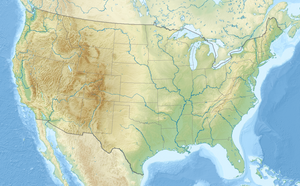Barren Run is a 5.63 mi (9.06 km) long 2nd order tributary to Jacobs Creek in Westmoreland County, Pennsylvania.
| Barren Run Tributary to Jacobs Creek | |
|---|---|
| Location | |
| Country | United States |
| State | Pennsylvania |
| County | Westmoreland |
| Physical characteristics | |
| Source | Lick Run divide |
| • location | about 0.5 miles west-northwest of Mendon, Pennsylvania[2] |
| • coordinates | 40°11′00″N 079°27′02″W / 40.18333°N 79.45056°W[1] |
| • elevation | 1,160 ft (350 m)[2] |
| Mouth | Jacobs Creek |
• location | about 0.5 miles southeast of Jacobs Creek, Pennsylvania[3] |
• coordinates | 40°07′16″N 079°43′20″W / 40.12111°N 79.72222°W[1] |
• elevation | 815 ft (248 m)[3] |
| Length | 5.63 mi (9.06 km)[4] |
| Basin size | 10.49 square miles (27.2 km2)[5] |
| Discharge | |
| • location | Jacobs Creek |
| • average | 13.59 cu ft/s (0.385 m3/s) at mouth with Jacobs Creek[5] |
| Basin features | |
| Progression | southwest[4] |
| River system | Monongahela River |
| Tributaries | |
| • left | unnamed tributaries |
| • right | unnamed tributaries |
| Bridges | Mendon Road, Charlies Road, Mendon Road, PA 981, JD Smith Road, Mt. Etna Road |
Variant names
editAccording to the Geographic Names Information System, it has also been known historically as:[1]
- Barnes Run
Course
editBarren Run rises about 0.5 miles west-northwest of Mendon, Pennsylvania,[2] and then flows southwest to join Jacobs Creek about 0.5 miles southeast of Jacobs Creek.[3]
Watershed
editBarren Run drains 10.49 square miles (27.2 km2) of area, receives about 41.4 in/year of precipitation, has a wetness index of 340.38, and is about 58% forested.[5]
References
edit- ^ a b c "GNIS Detail - Barren Run". geonames.usgs.gov. US Geological Survey. Retrieved 18 November 2020.
- ^ a b c "Get Maps". USGS Topoview. US Geological Survey. Retrieved 18 November 2020.
- ^ a b c "Get Maps". USGS Topoview. US Geological Survey. Retrieved 18 November 2020.
- ^ a b "ArcGIS Web Application". epa.maps.arcgis.com. US EPA. Retrieved 18 November 2020.
- ^ a b c "Little Sewickley Creek Watershed Report". US EPA Geoviewer. US EPA. Retrieved 18 November 2020.

